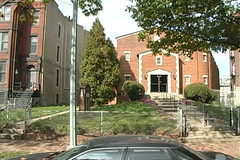Traceries will write what you want, so long as you pay
 Hired Gun. By Jiri TUREK, 2004. From www.gallery.cz.
Hired Gun. By Jiri TUREK, 2004. From www.gallery.cz.See "Preservation Board Consideration of Razing 1940s-Era Church Confounds Preservationists Seeking Consistency " from the Intowner, about the church at 610 Maryland Avenue, NE. The building didn't strike me as being particularly significant, not that I go around pushing for demolition. Plus, the building is set waaaay back, which I find disconcerting from an urban design standpoint. Still and all, I suppose I should read the report.
My experience with Traceries comes from their writing anti-historic preservation significance reports for clients BP Amoco and Trammell Crow, companies that are hardly big supporters of preservation... I will say the reports are well written*, but challengeable (fortunately). But they have an advantage in that they are paid, while advocates "pay" in their own personal time, to counter. I'm not happy about it, but at least I do know what to expect.
* I also read the EHT Traceries-produced nomination for the creation of the Hyattsville National Register District. The context statement that they produced is a good read, well organized, and a model for similar neighborhoods working on their own nominations.
 610 Maryland Avenue, NE. Note the windows installed in the party wall in the house of the likely Traceries client. Photo from maps.a9.com.
610 Maryland Avenue, NE. Note the windows installed in the party wall in the house of the likely Traceries client. Photo from maps.a9.com.From the submission: "the architectural design of the church constitutes a controlled presentation in juxtaposition to the personalized emotional character of the Pentecostal denomination."



0 Comments:
Post a Comment
<< Home